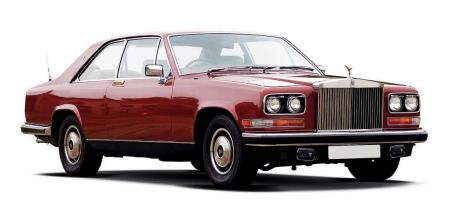An anatomy of the Rolls-Royce Camargue
When Rolls-Royce collaborated with Italian coachbuilder Pininfarina for its new 1970s flagship, the Camargue was the distinctive but divisive outcome. Almost 50 years on, the car is still a contentious subject.
WORDS: RICHARD GUNN
PHOTOGRAPHY: KELSEY ARCHIVE / RICHARD GUNN
CAMARGUE HISTORY THE BRAVEST MODEL?ANATOMY OF… ROLLS-ROYCE CAMARGUE
The bravest model in Rolls-Royce history? Discuss.
Few Rolls-Royces have ever created quite so much debate as the Camargue. And nearly 40 years on from the last one, Crewe’s flamboyant flagship of the 1970s and 1980s remains a talking point. It is a Marmite machine (albeit Marmite from Harrods’ food hall of course), loved and… well, loathed may be too strong a word, but certainly unappreciated, in equal measure. For the record, here on RR&BD, we’re very fond of the Camargue and its dramatic Pininfarina styling. But we can also understand why others haven’t warmed to it, against a backdrop of cars that trod a safe, conservative line. It is the Camargue’s looks that have generated so much debate.

The 1968 Bentley T-Series coupe that Pininfarina created for the London Motor Show probably did much to win it the contract for the Camargue. Elements of the show car made it into the production model.
The Ferrari 365 GT4 2+2, launched in 1972, was another Pininfarina design where the lines were broadly reminiscent of the Camargue.
Two of the Delta project prototypes, with D3 on the right. Note the rectangular headlamps fitted to the experimental car on the left.
Underneath that striking, impassive appearance, the luxury leviathan was essentially a Silver Shadow. On top though, it could be seen as an attempt to recapture something of the old coachbuilt days of more individualistic cars. The Silver Shadow’s monocoque construction had made things very difficult for traditional body builders, who were no longer able to transfer their own coachwork to separate rolling chassis. At first James Young and then Rolls-Royce’s own coachbuilder, Mulliner Park Ward, addressed the issue with the twodoor saloons and drophead coupés that were rechristened Corniches in 1971. But although these had a distinctive flair, there was still a great deal of Silver Shadow in their make-up. Rolls-Royce wanted to go further, with something that was very much of its time and also differed considerably from the Shadow’s very recognisable style. Cue Pininfarina, cue Camargue, cue controversy…
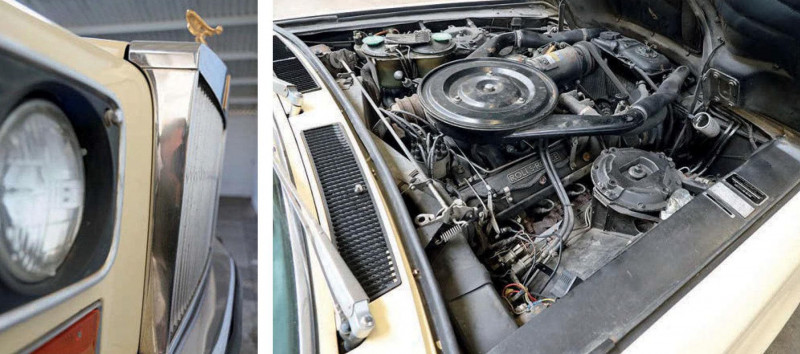
The Camargue’s grille sloped forward at a seven degree angle; the first time it had ever been anything but totally vertical on a production Rolls-Royce.
The Camargue featured the expected 6.75-litre V8, but after 60 cars had been built, the SUs were replaced by a fixed-choke, four-barrel Solex 4A1 carburettor to improve power and performance.
Initial planning for a more exclusive model began at the end of the 1960s. However, rather than give the task to Crewe’s very busy in-house styling team, Rolls-Royce’s new managing director Geoffrey Fawn decided to look not just beyond the company, but also beyond Britain. Italy’s coachbuilders had a particularly rich recent history of clothing British vehicles – the Triumphs of Michelotti, the British Motor Corporation’s relationship with Pininfarina, Aston Martin’s and Jensen’s fruitful flirtations with Touring of Milan and AC’s association with Frua – and so seemed the obvious choices. Of all the great Italian carrozzerie, it was Pininfarina that already had a connection with Rolls-Royce. Beyond its bespoke bodywork for separatechassis cars of the past, it had created a one-off Bentley T-Series coupe for the 1968 London Motor Show.
While the result wasn’t completely harmonious – the rectangular headlamps in particular looking somewhat at odds with the curved Bentley grille – it did have the virtue of looking nothing like the Shadow/T-Series design on which it was based.
CODENAME DELTA
During the 1960s and 1970s, Pininfarina of Turin, founded by Battista ‘Pinin’ Farina in 1930, was probably Europe’s pre-eminent design and coachbuilding concern. A prime factor in this was its work with Ferrari, with the 1968 365 GTB/4 Daytona just one of many fabulously attractive results. According to Rolls-Royce’s chief engineer at the time, John Hollings, Pininfarina was the only company considered for collaboration. So, during 1969, Crewe made contact and pitched the brief for a new top-of- the-range two-door, four-seater fixed head coupe. The project was given the codename Delta. The idea of an outside design firm, however prestigious Pininfarina might have been, was not received with universal delight by Rolls-Royce’s own styling team after its recent successes.
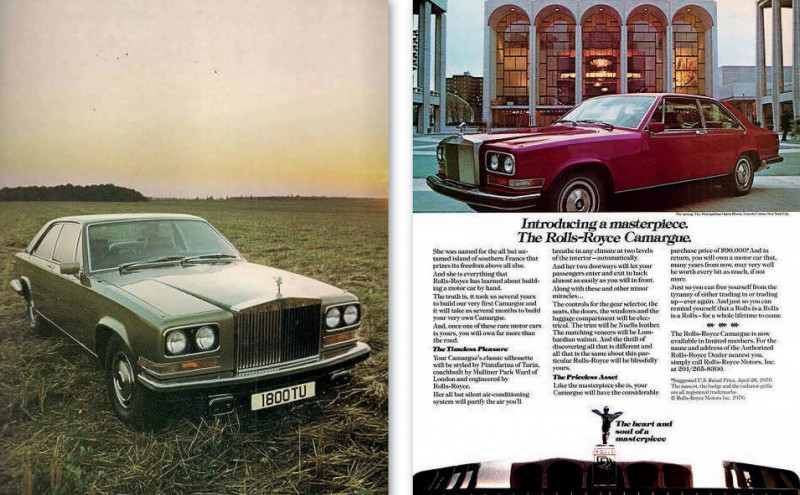
One of the 1975 press cars, also used for promotional and marketing material.
A 1976 American advert for the Camargue; its cost at the time was $90,000, which Rolls-Royce admitted was ‘considerable’.
However, the new senior management was adamant that a fresh approach was needed for the new decade.
Pininfarina wasn’t given a completely free hand for Delta, and the strict guidelines from Crewe contributed to the Camargue’s slightly incongruous appearance. The platform had to be that of the Silver Shadow, as was the traditional Rolls-Royce grille at the front, even if it could be a little lower and wider than that of the Shadow. It was also inclined seven degrees; the only previous Rolls-Royce with a forward-sloping radiator shell was Lady Penelope’s pink FAB 1 from Thunderbirds. That wouldn’t be lost on the Camargue’s future detractors.
But this went against the low bonnet line trends of the day; something Pininfarina was certainly used to with its Ferraris. Having to incorporate the large radiator shell dictated a bulky, somewhat slabby frontal appearance. The substantial V8 engine and the new air conditioning system under the bonnet didn’t exactly encourage athletic aerodynamics either. Then there was the need for adequate and comfortable rear passenger space plus a boot of Grand Touring luggage proportions, which dictated that the fastback roof couldn’t be too extreme. However the new Rolls-Royce was going to turn out, a Ferrari Daytona it would not be. The 1968 London Motor Show Bentley T-Series undoubtedly helped influence the ideas that Pininfarina came up with. Eight proposals were presented by Sergio Pininfarina during a London meeting at the start of the 1970s. Of those, it was a Paolo Martin concept that was chosen, albeit with changes – there wasn’t much enthusiasm for having the window frames finished in black instead of chrome as intended, to make the glasshouse look bigger. However, the decision to drop this aspect, radical as it was for a Rolls-Royce to minimise brightwork, seems to have been less about how it looked and more about concerns as to how well it would wear. The front quad lights, while round, were set in rectangular panels that echoed those of the London Motor Show T-Series. With a final design accepted, clay models were created before work began on a prototype at Mulliner Park Ward’s premises during 1971.
This was despite the financial turmoil at Rolls-Royce during that year. And then Fiat launched its 130 Coupe… The large Fiat Grand Tourer was also a Pininfarina design by Paolo Martin and its angular looks bore a distinct resemblance to Rolls- Royce’s forthcoming flagship. Cars for different marques in different countries having similar looks weren’t that uncommon in the days before vehicles were widely exported, and Pininfarina already had previous form. Its 1959 Farina family saloons for the British Motor Corporation, typified by the Austin A55 Cambridge MkII and Morris Oxford Series V, were spookily close to the Fiat 1800 of the same year and the Peugeot 404 of 1960. But in the early 1960s, a typical Cambridge or Oxford owner might never come across one of his car’s continental counterparts. By the following decade though, the world had shrunk, and growing European exports and less automotive isolationism made such a scenario less likely. The first alarm bells were reputedly sounded by a motoring journalist who had some inside knowledge of project Delta, and drew parallels between it and the new Fiat.
WEARING THE SAME DRESS
Rolls-Royce was sufficiently spooked that an emergency meeting was called to compare the two cars. That there was a similarity seems to have been accepted but as future chief stylist Graham Hull (back in 1971 a new recruit to Crewe) later commented,
Although the two vehicles were clearly related, it wasn’t a case of two women wearing the same dress at a social function. Pininfarina has always denied any copying but its case probably wasn’t helped by the subsequent launch of their Ferrari 365 GT4 2+2 in 1972 which also had a side profile close to the 130 Coupe and embryonic Camargue, albeit with sportier, sloping nose, and from the pen of Leonardo Fioravanti rather than Paolo Martin.
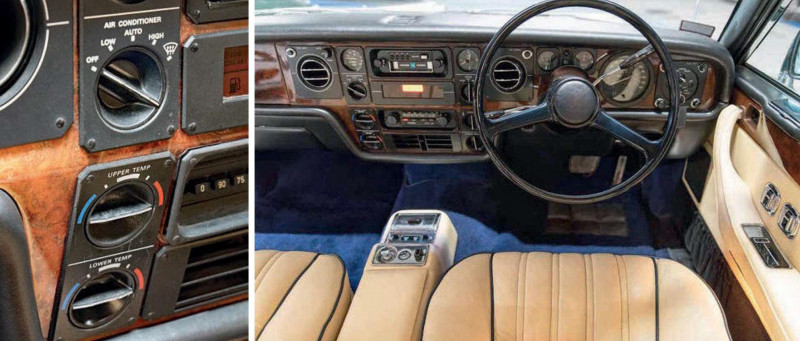
The split-level automatic air conditioning was regulated by just three controls.
The gauges, controls and vents fitted in black panels over the top of the Lombardian walnut veneer gave the dash of the Camargue something of an aircraft appearance – which was intended.
The first prototype Camargue was running by mid-1972; it would soon be followed by three more, all sporting Bentley grilles. The opinion among Rolls-Royce’s own designers was that it looked too bulky, inelegant and somewhat down at the rear end. One engineer allegedly likened it to the Rock of Gibraltar. But by this stage, there was little action that could be taken. The only real change carried out by Crewe’s team was to add small tell-tale embellishments to the front wings to aid manoeuvring. After the D1 prototype, D2 was used for crash testing, while D3 eventually became a launch publicity model and was also, at one point, trialled with a 7.25-litre V8. D4 was built in 1973, the year the Camargue was originally intended to debut. However, Rolls-Royce’s own financial problems, an industrial dispute, the set-up of the factory for production and issues perfecting the new air conditioning all served to delay matters. This postponement at least enabled further comprehensive testing, with D4 completing around 50,000 miles, most of them in France. It also allowed the fuel crisis of 1973 to pass, something that might have adversely affected the appeal of such a large and thirsty luxury vehicle. In January 1975, Sicily was the appropriate venue for the unveiling of the Italian-flavoured Rolls-Royce.

When the Fiat 130 Coupe came out in 1971, its similarity to the forthcoming Camargue did cause some concern at Rolls-Royce. The Camargue from the rear; from any angle, it was a very substantial-looking machine.
However, its name followed the convention set by the Corniche, referring to a French location. In the case of the earlier two-door cars, it was the coastal roads of France, especially the beautiful Grand Corniche on the Riviera, that the title echoed. The Camargue region wasn’t that many miles away, being south of Arles where the Rhone river split into two before flowing into the Mediterranean. It was also a type of horse from the area, known for stamina, hardiness and agility – all qualities that Rolls-Royce hoped customers would also find in its new model. At £29,250, the Camargue was the most expensive production car in the world; the equivalent of almost two Silver Shadows and a considerable premium over the Corniche. The typical build process took around six months, with Pressed Steel in Cowley constructing the floorpan, which was then sent to Mulliner Park Ward’s premises in Willesden, London for the bodyshell to be added. Then it was off to Crewe for mechanical fitting out, rustproofing and paint priming, before returning to MPW for completion. Thanks to demand for Corniches – also bodied at MPW – blunting manufacturing capacity, those who ordered a Camargue could potentially wait for up to two years before delivery. The situation was exacerbated due to variable panel quality. In 1978, Motor Panels of Coventry took over MPW’s bodybuilding responsibilities, with the cars then completely finished at Crewe once they’d left Coventry.
PININFARINA FLOURISHES
Aside from the exterior, there were other Pininfarina flourishes that marked the Camargue out. Inside, while there were the expected acres of high-quality leather and wood, the gauges and switchgear were mounted in black panels overlaying the walnut veneer rather than being behind or in it. This was done because behind the thin sliver of timber was mounted on aluminium, to improve safety and keep weight down. The overall effect resembled something from an aircraft – a nod to Rolls-Royce’s aviation links. Ironically, when the Camargue was being designed, the car division and the aeronautical arm were all one company, but by the time it was launched, the two had split and Rolls-Royce Motors was independent from Rolls-Royce Limited. The interior felt more open and less claustrophobic than previous two-door machines from the marque, thanks to the slimmer pillars. Mechanically, everything was pretty much Silver Shadow spec, save for the adoption of a fixed-choke, four-barrel Solex 4A1 carburettor after 60 Camargues had been built. This increased power slightly, and thus performance. Of course, how much power wasn’t officially revealed by Rolls-Royce, but 256bhp seems to be a generally-accepted ballpark figure. Cars for the USA and Japan retained twin SU HD8 carburettors.

One of the few things added by Crewe’s design team was these tell-tale embellishments on the top of each front wing, to help drivers judge more accurately where the corners of the car were. Because of the need to accommodate a typically plush level of rear accommodation, the sloping roof line couldn’t be too extreme.
Some consideration may have been given to fuel injection, but nothing around at the time met the exacting standards expected of a Rolls-Royce. While the Camargue provoked a mixed response, perhaps it didn’t matter that much. It was always going to be a very exclusive, very expensive model produced in small numbers. Therefore, it didn’t need that many customers to want one – just enough who were prepared to pay the fantastic price for a Rolls-Royce that bucked the norm.
Changes to the Camargue throughout its 11-year life were relatively few. Rack-and-pinion steering was adopted in 1977 along with a front spoiler, while the more effective rear suspension from the forthcoming SZ generation cars year. During 1984, the price soared to a lofty £83,122, while in-house competitors such as the Bentley Mulsanne Turbo had arguably stolen the Camargue’s thunder. The final examples were built in 1986, albeit the last dozen didn’t make it across the Atlantic for American sale until early 1987. In total 526 were constructed over 11 years, and only 120 were right-hand drive. One of which belonged to Shirley Bassey…
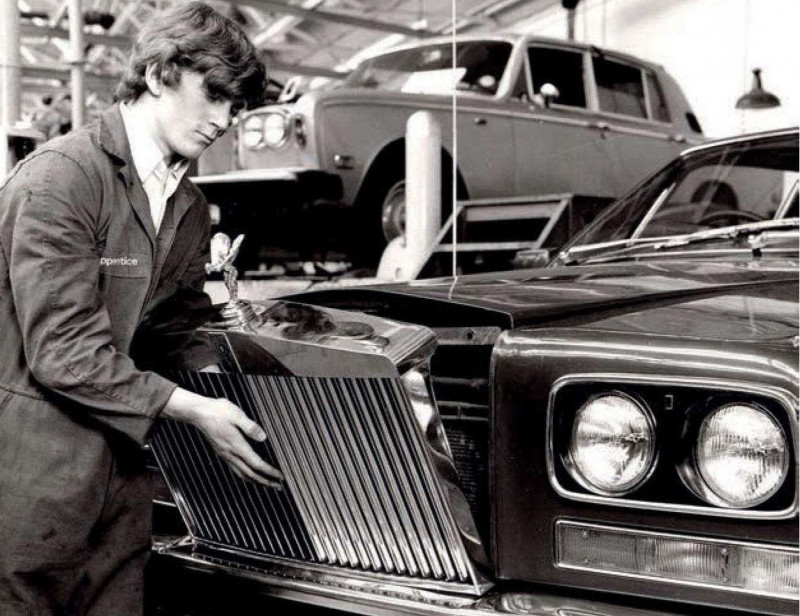
An apprentice at Crewe fitting a radiator surround to a Camargue. Back in 1983, it took one worker a day to make the shell; five hours were then spent polishing it.
Debates about the pros and cons of the Camargue continue, as they did throughout its life. It was something unexpected and leftfield from a car maker that usually played it safe and traditional. Even today, in a world of blueprint-busting Phantoms and Cullinans, opinions remain split over it. And maybe that’s no bad thing. If nothing else, as a thoroughbred classic, it’s always going to turn heads, always going to be talked about, and it will never, ever fade quietly into the past.

While all Camargue were fixed-head coupes as standard, convertible versions have subsequently been created, such as this one from the final batch of 12 sold in the USA during 1987. Fitted with a retractable hard-top by the Niko-Michael Coachworks, it was sold by RM Sotherby’s for $252,000 in January 2019.
In some of the brochures, there seemed a deliberate attempt to minimise the bulk of the Camargue.
THE INTROCAR VIEW
John Tupper, managing director of IntroCar, says:
Richard Gunn ably covers the fascinating story of how Rolls- Royce came up with a design that was so out of kilter with the rest of the model range, and even the historical oeuvre of coachbuilders and designers of «standard» Rolls- Royce models. We should remember that the Camargue was a product fresh from the political paroxysms of the 1960s and economic shocks of the early part the 1970s, emerging into a world where the status quo had been thoroughly upturned. This found its way inevitably into art, popular culture and design. It is only now — a whole 50 years later — that a fresh wave of enthusiastic owners are able to embrace the design and the context into which it was born. As an investment, the value of the Camargue seems only likely to travel north. The car is rare and usually owned by persons who regard the vehicle as a statement rather than an expensive run-around. As a car that can be maintained mechanically, the truth is that they are pretty much as easy to look after as a Silver Shadow or Silver Spirit, which means that availability of spares is excellent and expert technicians well represented (if you allow for the fact that they are usually pretty busy). In summary, anything mechanical can be fixed, and the specialist network is well-equipped to do so. For that reason, I will not go into depth into what to look out for in terms of the vehicle running gear, as previous articles cover that ad nauseum. I will recommend including the full chassis number with any parts enquiry. There are some wrinkles in what was fitted to the Camargue and when, which does not always correlate perfectly with a Silver Shadow or Silver Spirit (etc.) of the same year.
For those looking to own a unique part of the history of Rolls-Royce Motors, not many will be available for sale at any one time. Most ownership challenges will centre around the unique features of the car, by which I mean the interior and exterior trim and bodywork. Damaged and missing parts are likely to be difficult if not quite impossible to source. Creative solutions will be required, which takes time and costs money. Nevertheless, I am always surprised by how much is around. The spares are recognisable, so people in the know often realise what they are being offered when it turns up on the marketplace. If ownership is treated as a long-term prospect, then this is a car that is likely to become part of the family, and the process of preserving or making it better best viewed as such. I'm tempted to say that an owner should also consider themselves a conservator. This is a car that says something about itself, its owner, and history itself.
PRODUCTION FIGURES 1975 TO 1986
- Rolls-Royce Camargue: 525
- Bentley Camargue: 1 (1985)
‘Rolls-Royce wanted to go further. Cue Pininfarina, cue Camargue, cue controversy…’
BENTLEY BADGING
It may seem strange that the Camargue was theoretically available only in Rolls-Royce form, given that its sportier coupé appearance and enhanced performance might have made Bentley badging more appropriate. However, some Winged B variants were created. All the prototypes sported Bentley grilles during pre-launch testing and, in addition, D1 was also fitted with a turbocharger at one point, as part of a proposal for a high-performance Bentley version. While that only came to fruition with the Silver Spirit/ Mulsanne generation, the single Bentley Camargue Turbo proved capable of 145mph. In 1985, a single Bentley Camargue, albeit normally-aspirated, was officially produced as a special order for a customer. The Forest Green machine, registered B199 MDF, created a few headaches at the factory when it came to making the bonnet line blend in with the more curved radiator shell. The car still survives today.
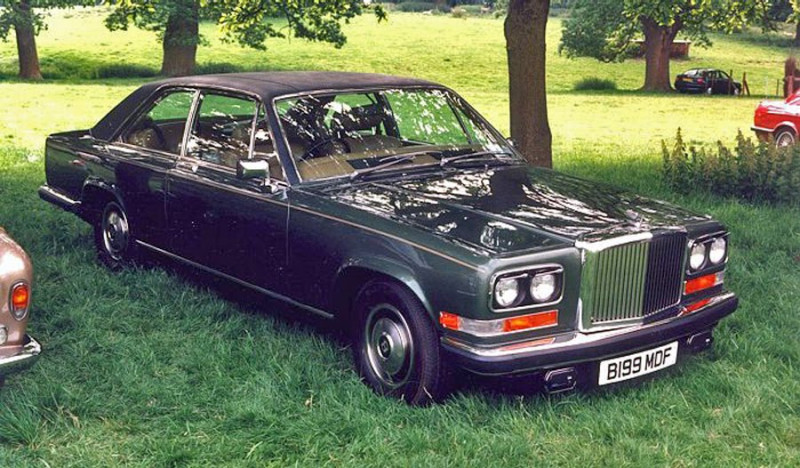
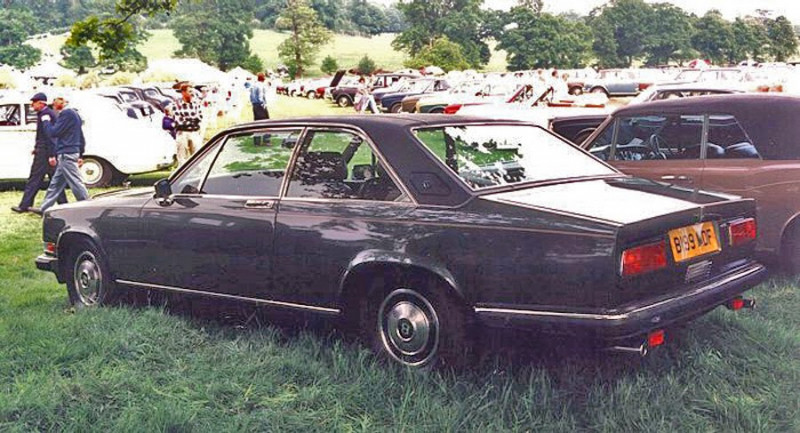
Bentley Camargue It is well known that there is only one Bentley Camargue.It was made in 1985 and has VIN SCBYJ000XFCH10150 in green.
AIR SUPPLY
One of the Camargue’s most hi-tech features was its advanced air-conditioning. Rolls-Royce claimed it had taken 10 years of development to perfect and it seems that problems during testing on prototype D4 during 1973, after everything else on the car had been resolved, contributed to the Camargue’s delayed launch. It reputedly cost the same price as a small saloon car to build. The system was fully automatic, and while this wasn’t new (Jaguar, for example, having come up with something similar in 1973), where the Camargue went further was that it was also split-level, distributing air at between 17 to 33 degrees Celsius (63 to 91 degrees Fahrenheit) at face and floor levels. To make this possible, four sensors were fitted inside and out, one of which even compensated for the sun glare. In theory, a Camargue could be driven from artic conditions to a tropical climate and the temperature would remain constant with no input needed from passengers. Almost half a century ago, this was a groundbreaking system. To explain it, Rolls-Royce’s instruction booklet ran to 30 pages, albeit going into much more proud engineering detail than strictly necessary. So advanced was the set-up that it was still in use in Corniches and Azures in 2003.


